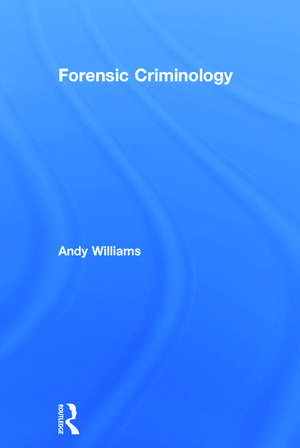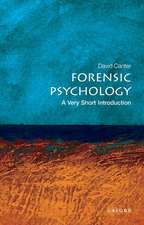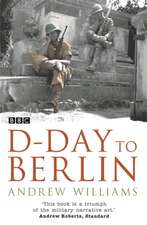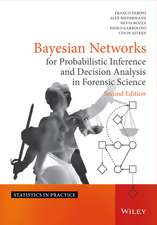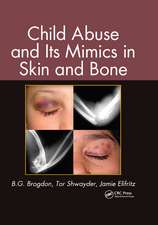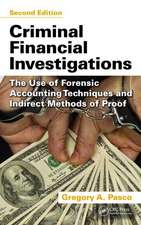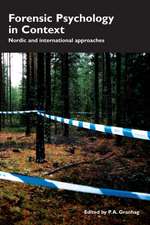Forensic Criminology
Autor Andy Williamsen Limba Engleză Hardback – 4 sep 2014
• the epistemological and ontological philosophies of the natural sciences;
• the birth of scientific criminology and its search for the criminal ‘body’;
• the development of early forms of forensic science and crime scene investigation;
• investigating crime;
• information, material and evidence;
• crime analysis and crime mapping;
• scientific support and crime scene examination; and
• forensic science and detection methods and forensics in the courtroom.
The text combines coverage of historical research and contemporary criminal justice processes and provides an introduction to the most common forensic practices, procedures and uses that enable the identification and successful prosecution of criminals.
Forensic Criminology is essential for students of criminology, criminal justice, criminal investigations and crime science. It is also useful to those criminal justice practitioners wishing to gain a more in-depth understanding of the links between criminology, criminal investigations and forensics techniques.
| Toate formatele și edițiile | Preț | Express |
|---|---|---|
| Paperback (1) | 439.47 lei 6-8 săpt. | |
| Taylor & Francis – 28 aug 2014 | 439.47 lei 6-8 săpt. | |
| Hardback (1) | 1284.86 lei 6-8 săpt. | |
| Taylor & Francis – 4 sep 2014 | 1284.86 lei 6-8 săpt. |
Preț: 1284.86 lei
Preț vechi: 1566.90 lei
-18% Nou
Puncte Express: 1927
Preț estimativ în valută:
245.89€ • 254.02$ • 204.64£
245.89€ • 254.02$ • 204.64£
Carte tipărită la comandă
Livrare economică 26 martie-09 aprilie
Preluare comenzi: 021 569.72.76
Specificații
ISBN-13: 9780415672672
ISBN-10: 0415672678
Pagini: 454
Ilustrații: 118
Dimensiuni: 156 x 234 x 25 mm
Greutate: 0.81 kg
Ediția:New.
Editura: Taylor & Francis
Colecția Routledge
Locul publicării:Oxford, United Kingdom
ISBN-10: 0415672678
Pagini: 454
Ilustrații: 118
Dimensiuni: 156 x 234 x 25 mm
Greutate: 0.81 kg
Ediția:New.
Editura: Taylor & Francis
Colecția Routledge
Locul publicării:Oxford, United Kingdom
Public țintă
Postgraduate and UndergraduateCuprins
1. Introduction Part 1: The Historical and Epistemological Backdrop 2. Constructed Knowledge and the Philosophy of Science 3. The Beginnings of 'Scientific Criminology' 4. The Beginnings of Forensic Investigation 5. The Beginnings of Criminal Investigation Part 2: Contemporary Forensic Investigations 6. Investigating Crime 7. Information Material and Evidence 8. Crime Analysis and Crime Mapping. 9. Scientific Support and Crime Scene Examination Part 3: Failsafe Forensics 10. Forensics Scientific and Detection Methods 11. Forensics on Trial.
Recenzii
‘This long-awaited book will become part of the foundational literature in forensic criminology. It is essential reading for students, practitioners, and academics who wish to fully appreciate the interplay between theoretical/substantive criminology and the practical world of forensic science, as well as everyday investigative and legal decision-making. Fortunately for both criminal justice professionals and general citizenry alike, the gap between theory and practice has just been substantially narrowed.’ - Daniel B. Kennedy, Ph.D., Oakland University and President, Forensic Criminology Associates, Inc., USA
‘This is a very timely and important book for the progression of forensic criminology. It uses an impressive array of literature and sources to provide a rigorous and robust overview of the historical and theoretical contexts which underpin contemporary forensic practice and relevant criminology. It demonstrates the tangible links between the evolution of criminological thought and its utilisation in forensic practice without adhering to a formulaic description of tasks, science and technologies. Instead, this book offers an interesting and insightful overview of developments in regards to the relevant science, techniques and ideologies, which is augmented by a detailed commentary on their underlining application and development.’ - Dr Paul Smith, Institute of Criminal Justice Studies, University of Portsmouth, UK
‘A useful point of reference for all students of forensic criminology. This book concisely summarises historical developments and research through to current thinking in a logical framework from crime scene to court room.' - Terry Lowe, Head of Scientific Services Department, Hampshire Constabulary, UK
‘This is a very timely and important book for the progression of forensic criminology. It uses an impressive array of literature and sources to provide a rigorous and robust overview of the historical and theoretical contexts which underpin contemporary forensic practice and relevant criminology. It demonstrates the tangible links between the evolution of criminological thought and its utilisation in forensic practice without adhering to a formulaic description of tasks, science and technologies. Instead, this book offers an interesting and insightful overview of developments in regards to the relevant science, techniques and ideologies, which is augmented by a detailed commentary on their underlining application and development.’ - Dr Paul Smith, Institute of Criminal Justice Studies, University of Portsmouth, UK
‘A useful point of reference for all students of forensic criminology. This book concisely summarises historical developments and research through to current thinking in a logical framework from crime scene to court room.' - Terry Lowe, Head of Scientific Services Department, Hampshire Constabulary, UK
Notă biografică
Andy Williams is Principal Lecturer and Programme Area Leader at the Institute of Criminal Justice Studies at Portsmouth University. His main research areas are forensic criminology; forensic techniques and their uses and interpretation in court; dangerous offenders; public protection and offender profiling. His previous books include: The Anatomy of Serious Further Offending (Oxford University Press, with Mike Nash); The Handbook Of Public Protection (Willan, with Mike Nash); and The Myth of Moral Panics (Routledge, with Bill Thompson).
Descriere
This book provides a much-needed sociological and criminological analysis of the context in which techniques of forensic science are applied to identify and prosecute offenders. In attempting to bring together two interdisciplinary subjects (forensics and criminology), it is the first text of its kind in the UK.
Forensic Criminology will be essential for students of criminology, criminal justice, criminal investigations and crime science. It will also be useful to criminal justice practitioners.
Forensic Criminology will be essential for students of criminology, criminal justice, criminal investigations and crime science. It will also be useful to criminal justice practitioners.
